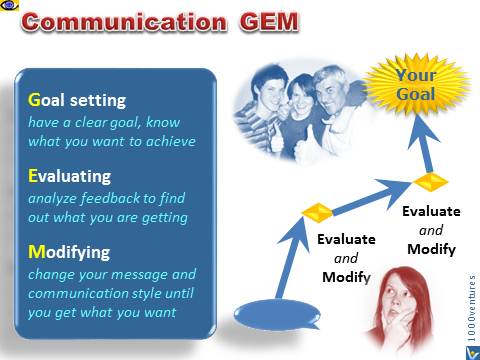|
| |
|
Learn how to communicate effectively your ideas to others if you want to
succeed in
life and
business.
|
|
|
| |
Realize that both the
sender and the receiver
filter messages
and that
the message they sent
is not the message
that was received. |
 |
|
Cross-cultural Communication |
 |
|
Don’t communicate in
a haste,
if required, transmit
the message in several
different forms. |
|
| |
|
"The meaning of your
communication is the response
you get."
~
NLP
Presupposition
|
|
|
 |
Speak from your
soul, and every soul
will open up and
respond. Speak from your
heart, and you will be
heard even when you are
silent. |
 |
|
|
|
The two parts of
a message – the content and the message – must complement each other.
Be sure of the appropriateness of the entire message you send. The major
barriers to successful communication are message overload, and message
complexity.
You must also realize that both the sender and the
receiver filter messages
and that the message they sent may not be the message that was received.
For
effective communication, avoid both too little and too much
communication.
Break complex messages into parts
and carefully explain the
relationship of the parts.
Pay attention to the messages being transmitted,
avoid premature evaluation of messages, and make use of a vocabulary common
to the individual whom the communication is being directed.
Pay also
attention to psychological phenomena that can interfere with effective
communication.
Defensive reactions operate in everyone without the individual being
conscious of their operation.
Any communication from either a senior or a
subordinate that is considered threatening can evoke a defensive reaction.
|
|
|
Overcome Barriers
To overcome barriers to and improve
interpersonal communication,
-
begin the communication process with the formulation of a message that is
clear and concise;
-
don’t communicate in a haste, if required, transmit the message in several
different forms;
-
use words that are part of the common vocabulary of the individual with whom
you communicate; recognize that different groups have different common
vocabularies and be prepared to change vocabularies as needed;
>>>
-
find a way to get your audience to explain what they think you said, discuss
differences until you hear a satisfactory version of the message you wanted
to convey;
-
seek confirmation of understanding of the message you sent, ask the receiver
to repeat your message in words other that those originally used to transmit
the message;
-
be attentive to both verbal and non-verbal messages, eg.
body language, in both sending and receiving;
-
know
which questions to ask – it will help you get the right response;
-
for very important communications, keep a written record so that later
disputes regarding meaning can be resolved by consulting the original
message.
|
|
*
Laconic writing:
I use "s/he" instead of "she or
he", "s/him" instead of "her or
him", "s/his" instead of "her or
his", "s/himself" instead of
"herself or himself" in my writings.
|
|